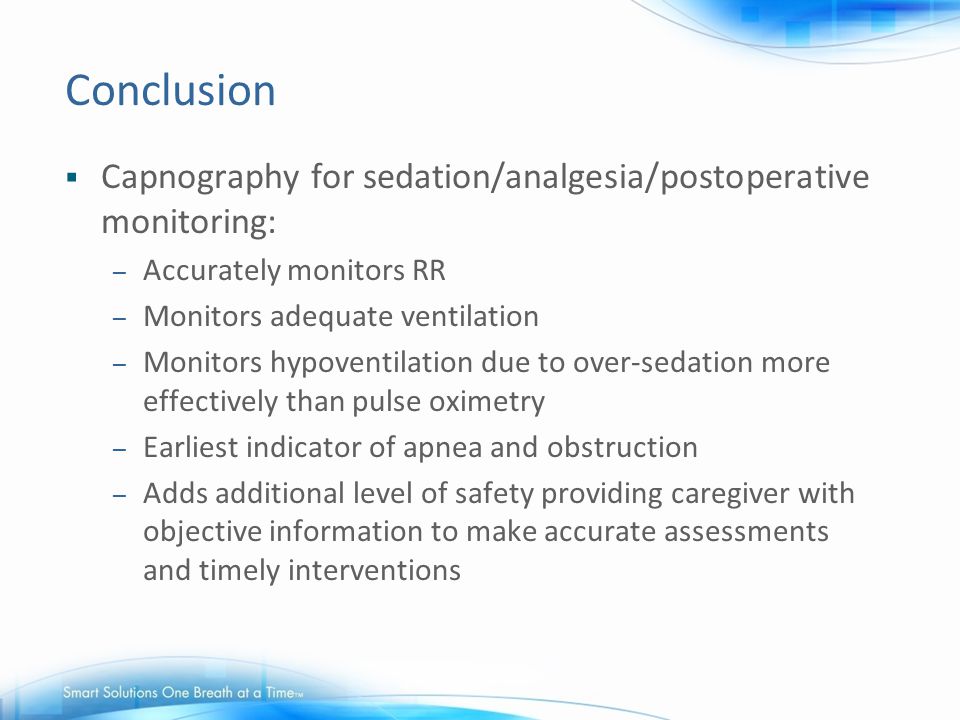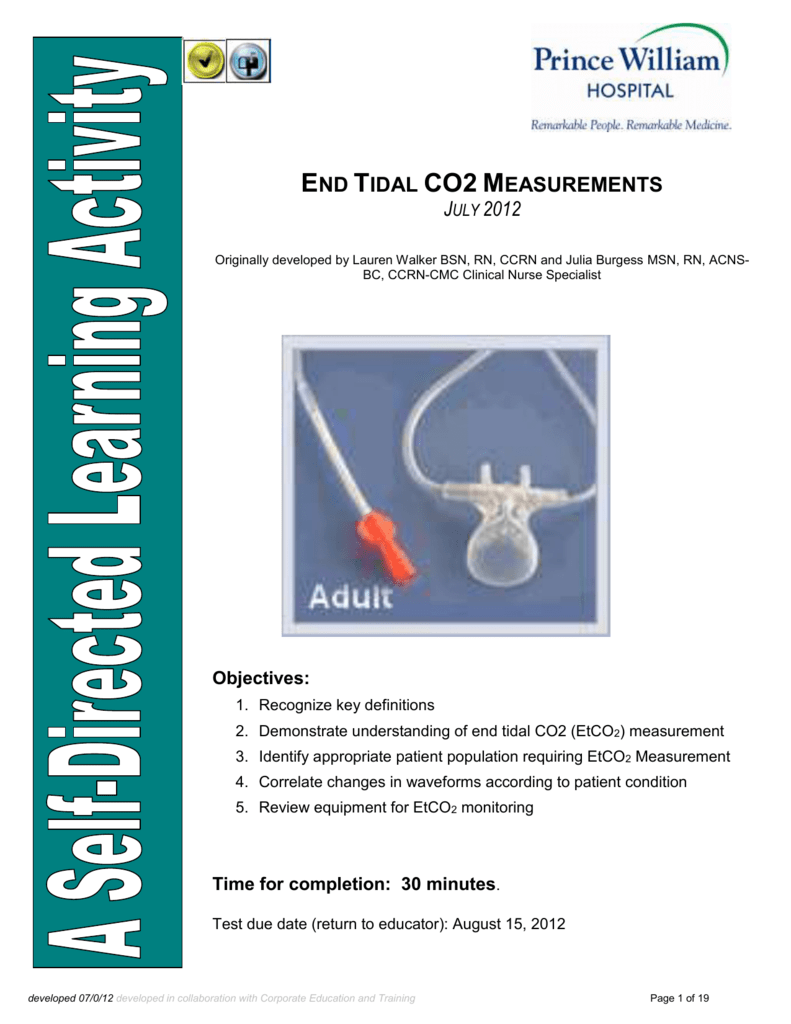end tidal co2 monitoring nursing considerations
In ETCO 2 monitoring a photodetector measures the amount of infrared light. End-tidal carbon dioxide ETCO2 is the level of carbon dioxide that is released at the end of an exhaled breath.
Safer Pca Therapy Patient Safety Quality Healthcare
End-tidal carbon dioxide ETCO2 is the level of carbon dioxide that is released at the end of an exhaled breathETCO2 levels reflect the adequacy with which carbon dioxide CO2 is carried in.

. Also called capnometry or capnography this noninvasive technique provides a breath-by-breath analysis and a continuous recording of ventilatory status. 1 Although commonly used in intubated patients receiving mechanical ventilation this technique is sometimes used in non-intubated patients. Optimal clinical application of this noninvasive monitoring technique requires an understanding of the physiologic principles of ETCO2 monitoring and its unique technologic considerations.
End-tidal CO2 ETCO2 monitoring is a common treatment for patients receiving mechanical ventilation within the critical-care or operating room setting. Adequate excellent hard-and-fast CPR will produce ETCO2 levels that are closer to normal 20 to 30-ish while lack of CPR or really bad CPR will produce ETCO2 levels that are practically nonexistent. ETCO2 is sometimes used for procedural sedation and during resuscitation.
ETCO2 levels reflect the adequacy with which carbon dioxide CO2 is carried in the blood back to the lungs and exhaled. CO2 monitors measure gas concentration or partial pressure using one of two configurations either. Pain management and sedation issues history of sleep apnea.
Attempt to stimulate and arouse the patient. Ventilation effective movement of gas in and out of the lungs. Safety feature to be used with all patient receiving PCA and PCEA infusions exception.
End-tidal CO2 ETCO2 monitoring is a common treatment for patients receiving mechanical ventilation within the critical care or operating room setting. Venous return CO2 from tissue to heart. ETCO₂ monitoring is a continuous way to accurately measure respiratory rate and CO₂ levels to provide safe monitoring of ventilatory status in extubated postoperative patients.
Association between prehospital cpr quality and end-tidal carbon dioxide levels in out-of-hospital cardiac arrest. End-tidal carbon dioxide monitoring refers to the noninvasive measurement of exhaled carbon dioxide and is most useful when applied directly to patient care. Introduction - Capnography for Monitoring End-Tidal CO2 in Hospital and Pre-hospital Settings.
Up to 24 cash back Attach the Filterline ETCO2 adaptor to the module by sliding a small door downwards. Defined as the monitoring of exhaled carbon dioxide through the respiratory cycle Measuring of End tidal CO2 is considered a standard of care for confirming endotracheal tube placement An important adjunct for assessing a critical patient The Journey of A Molecule Through the Respiratory Cycle. ET CO 2 monitoring helps ensure cor-rect endotracheal tube placement during intubation and helps evalu - ate respiratory and ventilatory status during procedural sedation or me - chanical ventilation.
Provides non-invasive continuous measurement of respiratory rate and exhaled CO2 concentration over time and is measured at peak expiration. A Health Technology Assessment - NCBI Bookshelf. End-tidal CO 2 monitoring in this setting provides the earliest indication of ventilation difficulty.
It is important to monitor the carbon dioxide to make sure the breathing tube is in the right place Rationale. 11 End Tidal CO2 monitoring ETCO2 via waveform capnography should be used to confirming correct placement of the endotracheal tube andor measure the adequacy of ventilation 12 For patients in cardiac arrest end tidal CO2 is a useful adjunct to treatment 121 Note. 24 The term capnometry refers to the.
Capnography or end-tidal exhaled carbon dioxide CO2 monitoring. Murphy RA Bobrow BJ Spaite DW et al. After profound circulatory collapse the end tidal CO2.
Measurement of end-tidal CO2 therefore requires. Capnography or End Tidal Carbon Dioxide ETCO₂ monitoring is the measurement of the partial pressure of Carbon Dioxide CO₂ at the end of an exhaled breath. Literature shows that monitoring end tidal carbon dioxide EtCO 2 in at-risk patients can facilitate early detection of ventilatory compromise.
Such information aids patient management and helps prevent clinical compromise. For this reason capnography is currently the most widely recommended method for monitoring ETCO25-8. If EtCO 2 is 45 to 50mmHg.
Mechanically ventilated and end of life. ETCO2 is sometimes used for procedural sedation and during resuscitation. First established in the 1930s clinical use.
End-tidal carbon dioxide ETCO 2 determines the carbon dioxide CO 2 concentration in exhaled gas to provide information about a patients pulmonary cardiac and metabolic status. Introduction - Capnography for Monitoring End-Tidal CO2 in. Its also valu - able in monitoring the effectiveness of cardiopulmonary resuscitation CPR and determining return of spontaneous circulation ROSC.
The capnogram changes immediately upon any decline in the respiratory pattern. In fact its commonly called the ventilation vital sign. Perceived lack of knowledge about how to identify patients in need for monitoring and how to interpret EtCO 2 data contributed to underutilization of this valuable monitoring tool by our PACU nurses.
End-tidal carbon dioxide ETco 2 monitoring provides valuable information about CO 2 production and clearance ventilation. The purpose of this study is to examine whether a relationship exists between arterial and end-tidal carbon dioxide tension PaCO2 and PETCO2 respecti. To facilitate safe and evidence-based care for this patient group nurses must have a good understanding of this physiological monitoring.
See Nursing considerations in ETCO 2 monitoring Capnography use during procedural sedation is now becoming commonplace. To facilitate safe and evidenced-based care for this patient group nurses must have a good understanding of this. The Philips monitor should automatically sense the End Tidal CO2 module and an End Tidal CO2 warming up message will be display in the top left hand side of the monitor.
Pulmonary blood flow CO2 from lungs to heart. It takes approximately 30 seconds for the module to warm up. End-tidal carbon dioxide ETCO2 monitoring is an effective tool to continuously assess the adequacy of ventilation in critically ill infants and children.
The point is keeping an eye on your ETCO2 during CPR will let you know if the compressions are adequate AND will alert you when there is a return of spontaneous. EtCO 2 35-45 mm Hg. EtCO 2 should be monitored in addition to pulse oximetry whenever respiratory depression is a possibility examples.
Monitoring ETCO2 is useful in confirming ET tube placement detecting inadvertent esophageal intubation and detecting life-threatening conditions such as displacement of the ET tube impending ventilatory failure and circulatory failure. End-tidal capnography end-tidal CO2 PETCO2 ET CO2 refers to the graphical measurement of carbon dioxide partial pressure mm Hg during expiration.

Waveform Capnography In The Intubated Patient Emcrit Project
Riding The Wave Of Capnography Understanding Etco2 Vetbloom Blog

Benefits And Disadvantages Of Waveform Capnography Download Table

Ppt Perianesthesia Nurses Association Of British Columbia Cathy Hanley Rn Bsn November 6 2010 Powerpoint Presentation Id 1977055

Capnography In The Pacu Theory And Clinical Applications Ppt Download

A Systematic Approach To Capnography Waveforms Jems Ems Emergency Medical Services Training Paramedic Emt News

Continuous Capnography In Pediatric Intensive Care Semantic Scholar

Pdf End Tidal Carbon Dioxide Etco2 Monitoring In The Post Anaesthesia Care Unit Pacu Douglas Mckendrick And Soo Yong Hui Academia Edu

A Systematic Approach To Capnography Waveforms Jems Ems Emergency Medical Services Training Paramedic Emt News
End Tidal C02 Monitoring Interpretation

End Tidal Co2 Icu Nursing Medical Knowledge Respiratory Therapy

Waveform Capnography In The Intubated Patient Emcrit Project

Pv Card Continuous End Tidal Co2 Monitoring In Cardiac Arrest Cardiac Arrest Cardiac Nursing Medical Knowledge

Nursing Recommendations On How Capnography Improves Patient Safety Physician Patient Alliance For Health Safety

Nursing Skills For Doctors Setting Up The End Tidal Co2 Monitor Youtube

1 Which Patient Would Be A Good Candidate For Etco2 Monitoring

Implementing Capnography In The Pacu And Beyond Journal Of Perianesthesia Nursing

Why You Should Care About Capnography And Etco2 Straight A Nursing